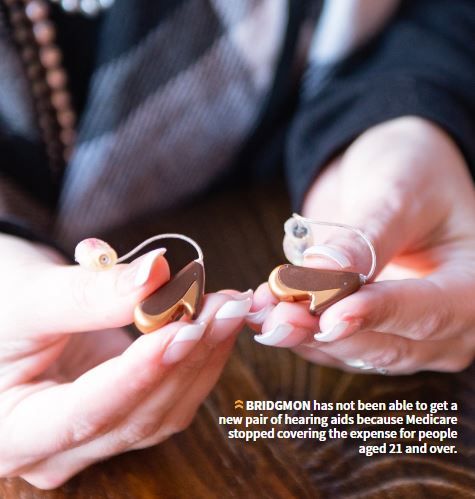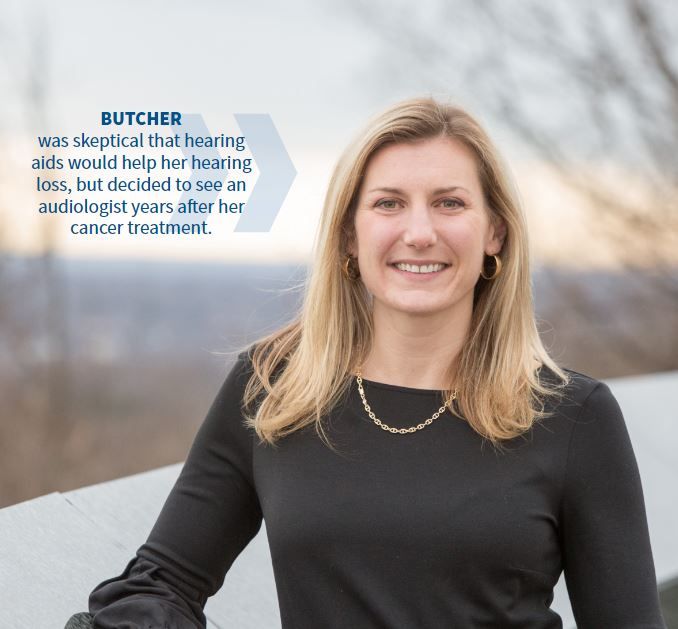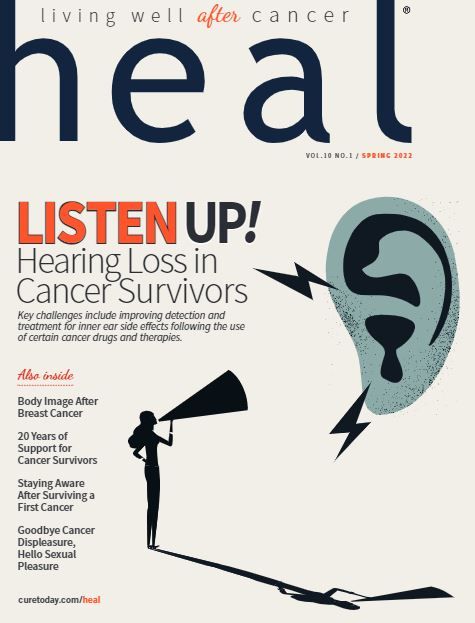Publication
Article
Heal
Listen Up: Hearing Loss Among Cancer Survivors Often Overlooked and Understudied
Author(s):
Significant challenges include improving detection and response to inner ear side effects among cancer survivors following the use of certain drugs and therapies.
Krista Bridgmon was 2 years old when her grandfather noticed that the right side of her jaw was enlarged, a symptom marking the beginning of a two-year battle to overcome a cancer of the nerve cells that had spread throughout her body.
Bridgmon, now 30, underwent chemotherapy, radiation, surgery and a bone marrow transplant to treat high-risk neuroblastoma (a cancer that starts during very early formation of nerve cells, mostly occurring in infants and young children), but the cisplatin chemotherapy that helped save her life was ototoxic, or damaging to her hearing.
She struggled to hear high-frequency sounds such as “s,” “th” and “f.” Discerning voices in noisy environments was particularly difficult. She was fitted with hearing aids, but the large, uncomfortable devices were painful and amplified all sounds. Whispering students and shuffling footsteps were sometimes louder than the teacher’s voice. She avoided crowds because it was almost impossible to follow conversations in a group, and she became increasingly shy as time went on.
“I felt embarrassed and less confident,” says Bridgmon, of Arley, Alabama. “I would nod and say, ‘yes’ even when I didn’t know what people were saying.”
She learned to read lips to compensate, but this strategy did not always work. She still relies on hearing aids when helping her daughter with homework or meeting with her doctors.
Why Hearing Loss Happens
Bridgmon is not alone in experiencing hearing loss after cancer treatment. Ototoxic platinum-based chemotherapy is commonly used to treat certain childhood cancers, including tumors affecting the brain, nervous system, liver and bones.
Krista Bridgmon cannot afford new hearing aids because Medicaid stopped covering this expense once she turned 21.

However, these drugs can cause hearing loss, tinnitus (ringing in the ear) and balance problems. Researchers have found that the platinum accumulates in a part of the cochlea called the stria vascularis, which regulates the makeup of the fluid that bathes sensory hair cells in the ear. The platinum is eliminated from other organs within days or months after an infusion but can be found in the inner ear years after treatment.
One study, published in The Lancet, demonstrated that hearing loss is most common among patients younger than 5 when receiving cisplatin, with 60% in this age group experiencing hearing problems years after treatment. Investigators from Children’s Hospital Los Angeles in California analyzed data from more than 1,400 patients in the United States who received cisplatin sometime between birth and age 40.
Investigators found that higher daily and cycle doses of the drug — such as regimens used to treat liver cancer, neuroblastoma and central nervous system tumors — increased the risk of hearing loss. Another study suggests that cranial radiation therapy can also be ototoxic, with 14% of patients reporting hearing loss at least nine years after treatment, according to a study of pediatric patients from St. Jude Children’s Research Hospital in Memphis, Tennessee.
Although studies like these are drawing attention to hearing loss and tinnitus among cancer survivors, there are still significant gaps in understanding how to prevent these long-term side effects, or late effects, and how to help patients experiencing them, says Dr. Emily Tonorezos, director of the Office of Cancer Survivorship at the National Cancer Institute in Rockville, Maryland.
“Hearing loss among cancer survivors has been overlooked and understudied,” she says. “People do not consider it a serious medical problem, and as a result there are many cancer survivors who struggle to communicate, feel isolated and experience neurocognitive difficulties.”
Like Tonorezos, Johnnie Bass, a research audiologist at St. Jude Children’s Research Hospital, suspected that hearing loss was affecting cancer survivors more than most clinicians realized. Parents would share that their children were struggling in school, needed speech and language services and were having behavioral issues.
To explore whether hearing loss was linked to neuro-cognitive function, Bass studied more than 1,500 patients in the St. Jude Lifetime Cohort who had survived childhood cancer five years or longer. Hearing loss in this population was associated with deficits in attention, executive function, processing speed, intelligence and academic function.
“The hearing loss can begin within days or weeks after treatment, and the damage is permanent,” Bass explains. “And the hearing problems can worsen over the years as people age.”
Hearing loss affects not only cognitive function among childhood cancer survivors, but also social development. Tonorezos recently interviewed childhood and young adult cancers survivors who were exposed to cranial radiotherapy, platinum chemotherapy or both, and hearing loss was associated with isolation and feelings of exclusion. Many of the survivors had deprioritized or neglected their hearing issues because the problem was a reminder of their cancer history, and they did not want to spend time and energy on hearing loss testing or treatment, says Tonorezos.
Improving Access to Care
As awareness increases about the prevalence of treatment-induced hearing loss, researchers hope providers will not only prioritize early screening to identify who may be at risk, but also refer patients to specialists who can provide treatment. Before starting potentially ototoxic therapies, clinicians should explain the potential immediate and long-term effects on the inner ear, says Kathleen Castro, a nurse consultant in the Office of the Associate Director of the Healthcare Delivery Research Program at the National Cancer Institute in Rockville, Maryland.
“If an ototoxic therapy is the best treatment for the cancer, in most cases the decision to move forward is clear,” she says.
But it is optimal for these patients to receive a baseline audiology test before starting treatment. Subsequent hearing tests can be compared with this baseline, says Castro.
“It is so easy to get focused on the moment when facing cancer, but it’s also critical to weigh what is at risk with long-term survival,” she says. If patients begin to show signs of hearing impairment, reducing the dose of chemotherapy may be a way to decrease risk of further damage, she adds.
To standardize audiology care for pediatric patients receiving ototoxic therapy, a group of international experts gathered to develop guidelines for clinicians. They determined that monitoring hearing and counseling from an audiologist should be considered before each ototoxic chemotherapy cycle. The specific monitoring recommendations for each patient are based on context, including the diagnosis, the drug, the dose and the child’s age.
The investigators found compelling data suggesting that, after treatment has been completed, “the screening needs to be tailored to a child’s age,” says Wendy Landier, one of the study authors. “Very young children should be screened more frequently than older children, but everyone who receives ototoxic therapy needs to be screened even as they move into adulthood,” explains Landier, deputy director of the Institute for Cancer Outcomes and Survivorship at the University of Alabama at Birmingham. Children under 6, for example, should be screened for hearing loss every year, and those from 6 to 12 should be screened every two years. For those 13 and older, screening is recommended every five years, according to the study.
If hearing loss is detected, clinicians can refer patients to an audiologist.
“These specialists are underutilized, and they are very knowledgeable about the resources available to address hearing loss,” Landier adds.
Raeanna Butcher, 33, of Montclair, New Jersey, benefited from seeing an audiologist but waited several years after cancer treatment because she was skeptical that hearing aids would help. She was diagnosed with pediatric osteosarcoma (a tumor that almost always occur in the bone, commonly near the growth plates of the knee, arms, legs and pelvis) during her sophomore year of college after her left knee started hurting during volleyball practices. She received two rounds of cisplatin before undergoing surgery to remove the cancer in her knee, and audiogram results during treatment revealed that she was suffering from high-frequency hearing loss.
During the two years after treatment, these issues resolved but Raeanna Butcher noticed the hearing loss was persistent. She would frequently ask people to repeat things and felt self-conscious in loud social settings when it was hard to hear.

But this problem was overshadowed by more acute consequences of treatment, including six months in a straight leg cast, mouth sores, numbness and tingling in her feet and complications from an intestinal bacterial infection.
During the two years after treatment, these issues resolved but Butcher noticed the hearing loss was persistent. She would frequently ask people to repeat things and felt self-conscious in loud social settings when it was hard to hear.
“I knew I was fortunate to have survived and wanted to put cancer behind me, but the hearing loss was always with me,” she says.
Butcher finally decided to see an audiologist, who explained that hearing aid technology had improved significantly over the years. He gave her a device programmed to help her hear high-frequency sounds, and for the first time in years she could easily follow conversations at large business events and social gatherings, including her own wedding.
Health insurance coverage for hearing aids for children and adolescents varies by state, and only a few states require insurance companies to cover hearing aids for adults, says Landier.
“Cost is a big problem,” says Bass, who found that only 23% of the cancer survivors with severe hearing loss in her study were using a hearing aid or cochlear implant.
Butcher paid $5,000 for her hearing aids; Bridgmon cannot afford new ones because Medicaid stopped covering this expense once she turned 21.
Hope for the Future
Researchers are starting to explore the possibility of preventing ototoxicity by using drugs such as sodium thiosulfate (STS), an antioxidant that binds to harmful molecules produced in cells that have taken up cisplatin. Scientists are working to understand why STS is otoprotective; they suspect the drug prevents free radicals from damaging the hair cells in the inner ear. It is also possible that STS binds to platinum, which could prevent residual cisplatin from killing cells in the ear.
In one recent study, published in The New England Journal of Medicine, children with localized liver cancer received STS six hours after each infusion of cisplatin. They were half as likely to experience permanent hearing loss as children who did not receive STS, and the drug did not decrease the effectiveness of the chemotherapy.
For now, STS is not widely used in cancer institutions, in part because more research is needed to determine whether the drug impacts the effectiveness of chemotherapy, says Dr. Stefanie Thomas, director of adolescent and young adult oncology at Cleveland Clinic Children’s in Ohio.
“For now, clinicians are sometimes using STS in children diagnosed with localized cancer, but not yet in metastatic disease,” she explains.
In the future, providers may also be able to identify genetic risk factors for ototoxicity. Childhood cancer survivors from the St. Jude Lifetime Cohort who underwent cranial radiation therapy were more likely to have hearing loss and tinnitus if they had a specific gene variation in certain chromosomes, according to a recent study.
Scientists also acknowledge that more research is needed to understand how cisplatin affects hearing and tinnitus in survivors of adult-onset cancer. Eager to study this patient population, Robert Frisina, director of the Global Center for Hearing & Speech Research at the University of South Florida, joined a multi-institutional team that is following more than 2,000 testicular cancer survivors who received platinum-based therapy. They found that 20% had hearing loss classified as severe to profound and 40% had tinnitus.
These initial findings were based on audiogram testing in which participants pressed a button if they heard a specific tone. The team now plans to expand the testing to evaluate speech processing amid background noise.
“I think our findings may surprise some oncologists,” says Frisina. “They may not realize that the hearing loss is so severe.”
He hopes that his work will highlight the consequences of ototoxic treatment, and ultimately help providers to be more attentive to cancer survivors who need audiological support and hearing aids.
Although awareness of this issue is increasing, screening and access to audiologists are not widespread. In the meantime, cancer survivors like Butcher encourage patients to be proactive in addressing hearing loss and tinnitus.
“Don’t continue to suffer,” she says. “I tried to ignore the problem because I didn’t want the effects of cancer to be part of my life, but it’s wise to educate yourself, talk to an audiologist and see what is available.”
For more news on cancer updates, research and education, don’t forget to subscribe to CURE®’s newsletters here.





